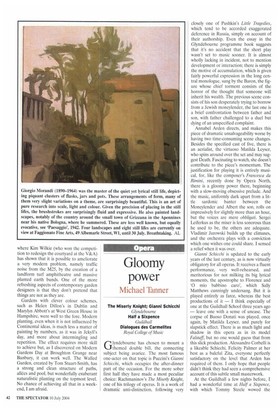Rollover, makeover
Ursula Buchan
T do not have much objection to televi.1 sion garden-makeover programmes, strangely enough. It is certainly odd for anyone to think that it is possible, let alone desirable, to make a garden in a weekend and expect it to stay made, but I see the point of encouraging a youngish generation, with no background in gardening, to have a go and find out for themselves the satisfactions inherent in the process.
There is, however, one way in which most TV gardening does thoughtful gardeners no favour. Proper, grown-up, contemporary garden design is obscured by the emphasis on DIY decking, solar-powered water 'features' and glass-bead gravel. Only at Chelsea Show time does it emerge briefly, like the lazy fin of a carp breaking the surface of a deep pool. The first Modern Gardens Day, held on the last Saturday in June, was intended to show that much else is possible — with thought, creativity and often, although not always crucially, with oodles of dosh. Because of the jejune nature of television gardening, gardeners can be forgiven for thinking that nothing very momentous has happened to public and private gardening in the past 20 years. But that is far from the case. For a start, garden design is now an accepted and respected profession, with its own Society and Journal. Perhaps because of this, a number of strong 20thcentury traditions have been losing their grip. The Jekyll planting tradition has given ground, as its high-maintenance impracticality becomes ever more glaring and we finally become bored with harking back to that Edwardian golden afternoon. The 'new perennial planting' is well established in the mainstream, thanks in particular to Keith Wiley, Piet Oudolf and Noel Kingsbury. We have also become much less insular. Foreign designers, such as Alain Provost and Alain Cousseran (Thames Barrier Park). Piet Oudolf (Scampston Hall and Pensthorpe) and Wirtz pere et fils (Alnwick Castle and Jubilee Tube station, Canary Wharf), are praised and feted.
Strict minimalism, formalism with a contemporary twist to it, and adventurous naturalism all seem acceptable these days. Although pre-war Modernism never took the hold in this country that it did on the Continent (perhaps because concrete looks so drab in the rain), it does not mean we do not appreciate asymmetry or the abstract, and we certainly respond favourably to, for example. Charles Jencks's sinuous landforms at Portrack and Edinburgh's Gallery of Modern Art.
English Heritage, which, together with the Association of Garden Trusts, sponsored the Modern Gardens Day, deserves credit for its Contemporary Heritage Gardens initiative: at Osborne House, Portland Castle, Richmond Castle, Eltham Palace, Witley Court and Lincoln Bishop's Palace. English Heritage has employed the darlings of contemporary garden design, such as Christopher Bradley-Hole, Mark Anthony Walker and Rupert Golby. This suggests an understanding that large, important gardens have always grown organically, in the sense of piecemeal and gradually, and that there is no uncomfortable paradox in an Elizabethan house having an 18th-century park and a 21st-century walled garden, provided that all is coherent, congruous and of excellent quality. This view has plainly also been taken by the Legards at Scampston Hall in north Yorkshire as well as the Chambers at Kiftsgate Court, in Gloucestershire, where the third generation of owners have added their own spin, in this case a new minimalist garden with pool where once there was a tennis court.
The gardens open on Modern Gardens Day were quite eclectic, the only common feature being that they had all been made, or partly made, in the last few years. They ranged from the Arts and Crafts Movement-influenced Bryan's Ground in Herefordshire, to Great Fosters in Surrey, where Kim Wilkie (who won the competition to redesign the courtyard at the V&A) has shown that it is possible to ameliorate a very modern problem, namely traffic noise from the M25, by the creation of a landform turf amphitheatre and massive planted earth bunds. One of the more refreshing aspects of contemporary garden designers is that they don't pretend that things are not as they are.
Gardens with clever colour schemes, such as Helen Dillon's in Dublin and Marylyn Abbott's at West Green House in Hampshire, were well to the fore. Modern planting, even when it is not influenced by Continental ideas, is much less a matter of painting by numbers, as it was in Jekyll's day, and more about intermingling and repetition. The effect requires more skill to achieve but, as I discovered on Modern Gardens Day at Broughton Grange near Banbury, it can work well. The Walled Garden, created by Tom Stuart-Smith, has a strong and clean structure of paths, allees and pool, but wonderfully exuberant naturalistic planting on the topmost level. No chance of achieving all that in a weekend, I am afraid.



























































 Previous page
Previous page